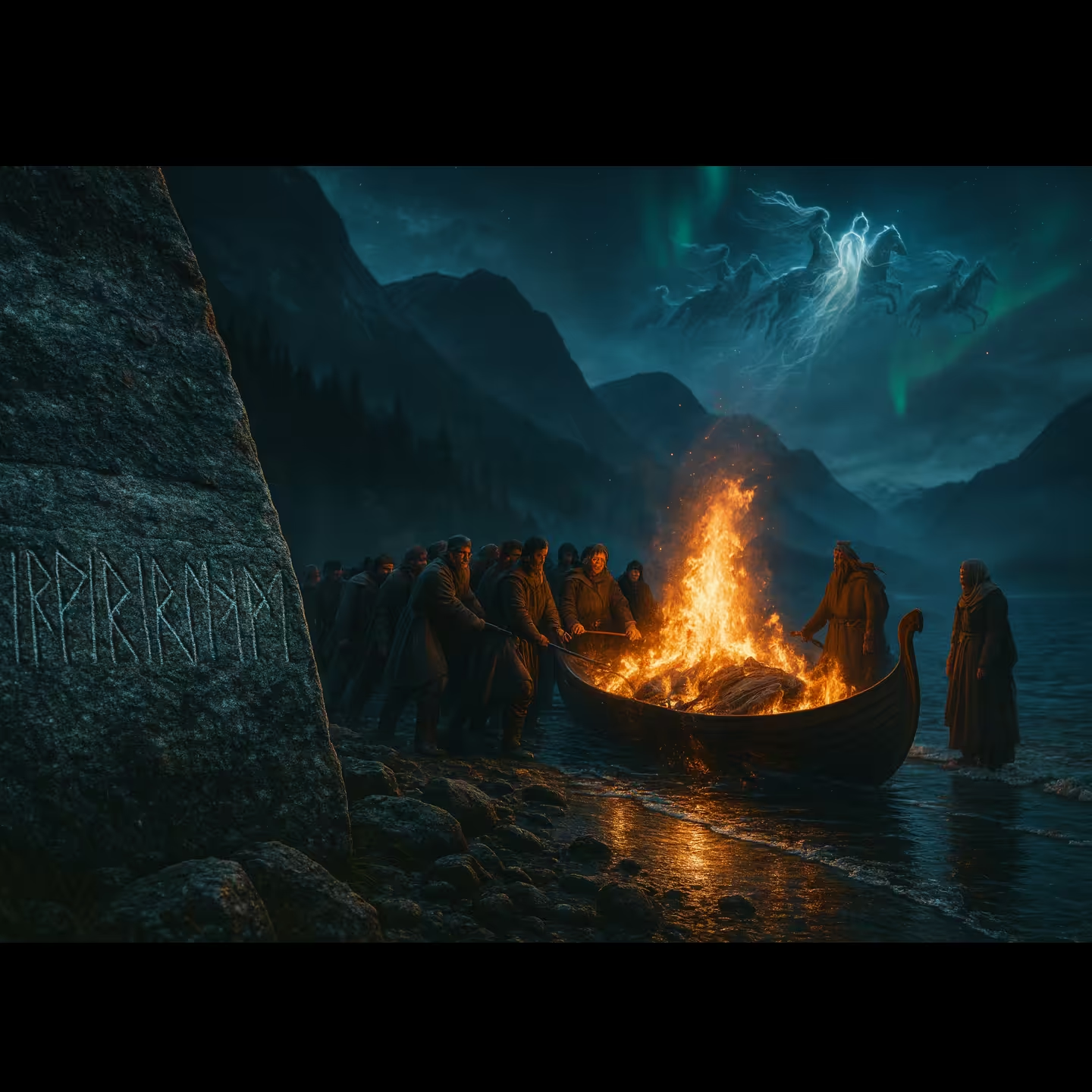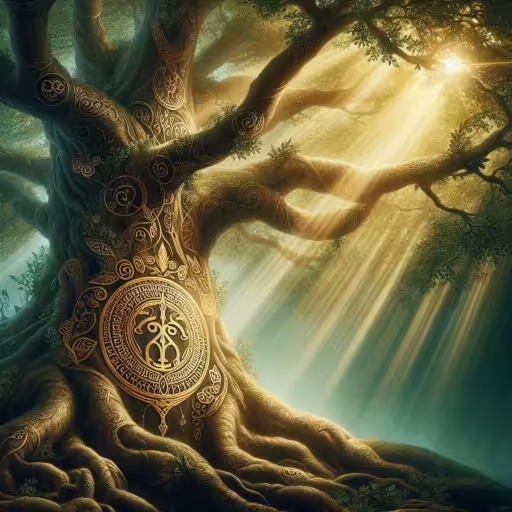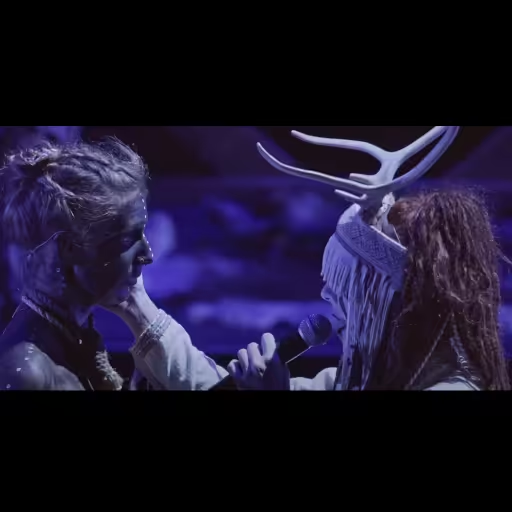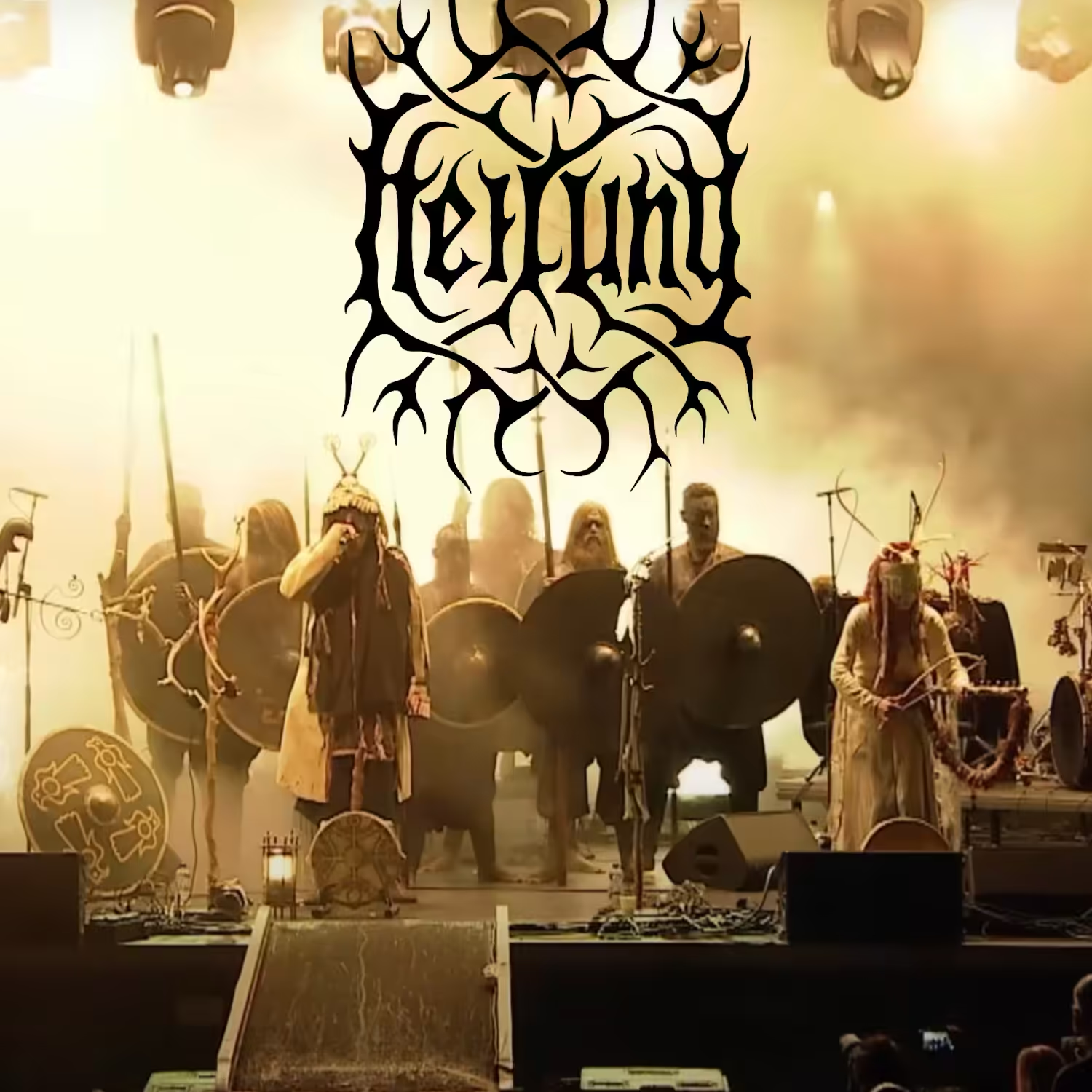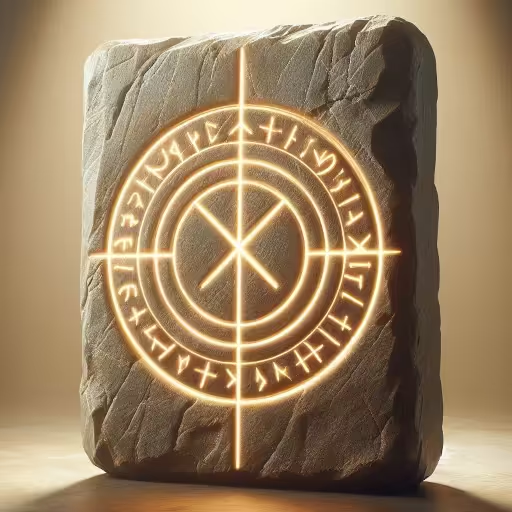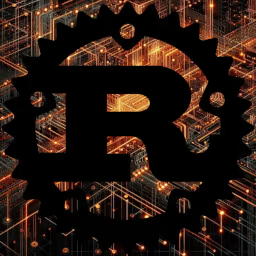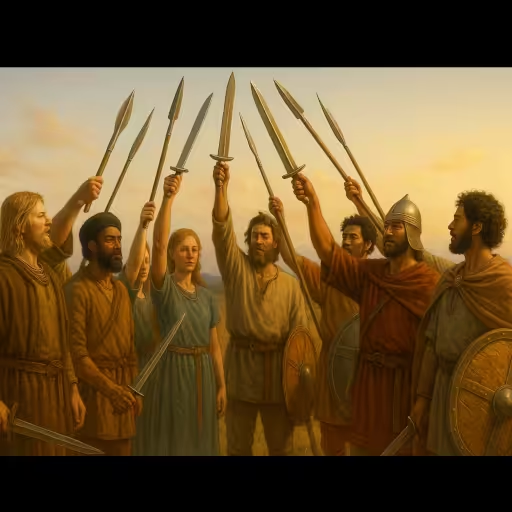Heilung — Krigsgaldr Lyrics and English Meaning
The melodic refrain in Krigsgaldr (“War Chant”) isn’t a made-up “proto-Germanic vibe”. Heilung are chanting (with minor normalizations/spacing changes) a stanza reconstructed from the Eggja runestone (Norway, c. 650—700 CE). Scholars usually cite Krause & Jankuhn (1966) and Grønvik (1985) for those lines; both analyses point to a funerary/ritual incantation (often compared to galdralag-style chant; applying a specific medieval meter to a 7th-century runic text is speculative) mentioning blood (“corpse-sea”), boat fittings, and a “harrier-god” (army-god) arriving—imagery that fits a rite for the dead, not a modern “war cry”. Heilung finally overlays a new English monologue about the grim ambivalence of violence, and when it must be used.
Heilung Music Video - Krigsgaldr
Check out our other article covering the lyrics and translation of Heilung’s Traust.
Meaning of “Krigsgaldr”: Eggja Stone and the Old Norse Runes
- krig (Scandinavian) = war; galdr (Old Norse) = a sung spell/incantation. So Krigs-galdr ≈ “war-incantation/war-chant.” (Wikipedia)
- The Eggja stanza Heilung adapts is commonly printed as: “Hverr of kom hæráss á / hí á land gotna? / Fiskr ór firna-vim svim(m)ande, / fogl á f(…) galande.” ≈ “Which harrier-god came here to the land of men? A fish out of the fierce waters, swimming; a bird on [—], calling.” (Wikipedia)
- Heilung’s own album page lists the refrain text essentially as they sing it (the spacing is theirs), and the track title is consistent with this sense. (Heilung)
What “language” Heilung is actually using
The sung chorus in Krigsgaldr is not a coherent, native Old Norse text, nor is it straight Proto-Norse. What they are doing is performative reconstruction:
- The base material is the Eggja stone inscription (c. 650—700 CE, western Norway), written in Elder Futhark runes.
- That text is fragmentary, ambiguous, and heavily debated among runologists. Whole words are broken, rune values contested, and there is no universally accepted translation.
- Heilung take Grønvik’s 1985 reconstruction as their scaffolding — but they reshape the phonetics into chantable syllables.
So what we hear in the album is closer to an artistic “Norse-sounding language”: partly faithful to Eggja, partly adjusted for meter, rhyme, and vocalization. It isn’t identical to Old Norse or Proto-Norse — it’s a stylized liturgical language designed for performance.
Why it diverges from the Eggja stone
Several reasons explain the divergences:
-
Meter and cadence: The original inscription doesn’t break neatly into chantable units. For musical repetition, Heilung often splits words (e.g., “gotna” → “got na”), or normalizes endings (e.g., “hverr” → “hu war”).
-
Phonetic accessibility: True Proto-Norse phonology isn’t easily pronounceable to modern singers or accessible to audiences. They adapt rune-words into sounds that fit a ritual chant aesthetic.
-
Ambiguity of the source text: Scholars themselves disagree on exact readings. Where Eggja is broken, Heilung has more license to interpolate or simplify.
-
Artistic ritualization: Heilung calls their music “amplified history.” Their goal is not philological precision but recreating the atmosphere of a Norse ritual. By chanting a half-understandable, archaic-sounding tongue, they blur the line between historical artifact and living incantation.
What inspired these changes
- Performance tradition: In Norse poetry, especially galdrar, repetition and rhythmic variation were essential to ritual function. By reshaping Eggja into refrain-forms, Heilung are echoing that tradition.
- Mystical effect: Keeping the lyrics only semi-intelligible (half “recognizable” Old Norse, half strange syllables) enhances the mystical and incantatory feel — it sounds ancient even to Scandinavian listeners.
- Continuity with their ethos: Heilung aren’t re-enactors; they describe their work as “ritual music” inspired by archaeological finds, myth, and linguistic fragments. The Eggja text serves as seed material rather than a fixed script.
✅ So, the Heilung version isn’t a “language” per se, but an artistic liturgical register:
- Rooted in Proto-Norse runic text (Eggja)
- Reshaped through Grønvik’s reading
- Altered for ritual chant and musicality
That’s why it diverges so much from the original runes — it’s not “mistranslation”, but deliberate transformation: turning a damaged inscription into a living galdr.
Heilung Lyrics + English Translation
Here are the complete song lyrics, with an approximate English translation, that you can copy and paste into a music file’s meta data lyrics for the next time you listen to Heilung - Krigsgaldr:
Fair-use note: Full lyric reproduction can be touchy; consider quoting short excerpts and linking the official page. We include the performance refrain here for commentary.
Min warb naseu
(that one cast/poured the corpse-sea [= blood])
Wilr made thaim
(with it he smeared [blood] on their thole-pins)
I bormotha hauni
(in the well-bored mast-top/fittings)
Hu war (hu war)
(who was it? who?)
Hu war opkam har a hit lot
(which 'harrier-/army-god' came here to the land of men?)
Got nafiskr orf
(a fish out of the fierce [waters])
Auim suimade
(swimming in the waters)
Foki afa galande
(a bird on [unknown surface/shore], calling/crying)
Hu war (hu war)
(who was it? who?)
Hu war opkam har a hit lot
(which 'harrier-/army-god' came here to the land of men?)
[Spoken bridge in English]
What am I supposed to do
(what am I supposed to do)
If I want to talk about peace and understanding
(if I want to talk about peace and understanding)
But you only understand the language of the sword
(but you only understand the language of the sword)
What if I want to make you understand that the path you chose leads to downfall
But you only understand the language of the sword
What if I want to tell you to leave me and my beloved ones in peace
But you only understand the language of the sword
I let the blade do the talking
So my tongue shall become iron
And my words the mighty roar of war
Revealing my divine anger's arrow shall strike
All action for the good of all
I see my reflection in your eyes
But my new age has just begun
The sword is soft
In the fire of the furnace
It hungers to be hit
And wants to have a hundred sisters
In the coldest state of their existence
They may dance the maddest
In the morass of the red rain
Beloved brother enemy
I sing my sword song for you
The lullaby of obliteration
So I can wake up with a smile
And bliss in my heart
And bliss in my heart
And bliss in my heart
Coexistence, Conflict, combat
Devastation, regeneration, transformation
That is the best I can do for you
I see a grey gloom on the horizon
That promises a powerful sun to rise
To melt away all moons
It will make the old fires of purification (of purification)
Look like dying embers
Look like dying embers
[refrains as above repeat]NOTE: For the chorus, the English gloss follows the Eggja readings; the exact objects (e.g., “bird on [—]”) include an uncertainty where the inscription is damaged (Wikipedia). For the chorus, I translated per Eggja scholarship (Krause—Jankuhn / Grønvik, with uncertainties noted). “Harrier” or “harry” comes from Old English hergian which means to “make war, lay waste, ravage, or plunder”.
Where the “land of men” Lyric Comes From
Things get a bit slippery in the scholarship versus Heilung’s performance.
The Eggja inscription (the actual runes behind Heilung’s chorus) doesn’t have the words hit lot in isolation. In the standard scholarly transcriptions (Krause & Jankuhn 1966; Grønvik 1985), the relevant line is:
“hverr of kom hæráss á hi á land gotna”
- hæráss = “harrier-/army-god” (often read as an Odin-like epithet in a psychopomp role)
- á hi á land gotna ≈ “onto this land of men”
Here, gotna is a genitive plural yielding “land of men/warriors.”
When Heilung chant “hu war opkam har a hit lot”, they are singing a stylized, compressed form of that line:
- Hu war = “hverr” (who)
- opkam = “of kom” (came here/up)
- har = “hæráss” (harrier-god)
- a = “á” (onto, to)
- hit lot = Heilung’s sung reshaping of “hi á land gotna.”
So “land of men” is not a direct translation of "hit lot" as two words. It’s a gloss of the underlying Eggja line that Heilung is singing in stylized syllables.
Literal Translation of Heilung’s Reinterpretation
If we ignore the smoothing and just parse Heilung’s sung syllables literally:
Hu war opkam har a hit lot ≈ “Who was (it) came here har(rier-god) onto this lot/fate.”
That’s probably the closest literal mapping of the words as they’re sung. But because we know the sung line is a performance condensation of “hverr of kom hæráss á hi á land gotna”, the academic translation expands it back to:
“Which harrier-god came here onto the land of men?”
Heilung Krigsgaldr Meaning: Eggja Stone Reading
Word-by-word: Heilung form → closest Eggja reading → gloss → sense
Interpretations vary; the best-known scholarly baselines are Krause & Jankuhn 1966 and Grønvik 1985. Heilung’s spacing is performance-oriented; several “words” in the song split or merge pieces of a single Eggja form
| Heilung sings | Eggja (K&J / Grønvik) | Morphological gloss | Sense in song | Notes |
|---|---|---|---|---|
| Min | hin(n) | demonstrative “that (one)" | "that one” (the actor) | Heilung’s m likely reflects a performance normalization; K&J read hin(n). |
| warb | varp | preterite ‘threw/poured/cast’ (varpa) | poured/cast | ”Cast/poured” suits a liquid rite. |
| naseu | náséo | ’corpse-sea’ (kenning) | blood | Standard kenning analysis in Eggja literature |
| Wilr | wilʀ (→ Grønvik’s Vill?) | proper name/will? | agent/subject | Grønvik takes Wil(l) as an agent/theonym; others read it syntactically with mannʀ. Uncertain. |
| made | máðe | ’smeared/rubbed’ | smeared | Refers to anointing/smearing the fittings |
| thaim | þeim | ’to them’ (dat. pl.) | ‘on the …’ | Object is supplied by next word(s) |
| I | í | ’in/onto' | 'in/onto’ | |
| bormotha | bormóða | ’well-bored, drilled’ | well-bored | Of wooden ship-parts |
| hauni | húni | ’mast-top; boat fitting’ | mast-top/fitting | Nautical term |
| Hu | Hverr (Huæaʀ) | interrogative ‘who' | 'who’ | The song’s hu ≈ hver |
| war | — | (part of Hverr in chant) | (—) | The sung “hu war” splits hverr across beats; not the verb vera ‘to be’ |
| opkam | of kom | ’came (up/hither)‘ | came | of is a preverbal particle; compressed in singing |
| har | hæráss | ’harrier-/army-god’ | Odin-like figure | Often glossed as an Odin epithet/psychopomp |
| a | á | ’onto, to’ | to/onto | |
| hit | hi(t) | ‘here/that place’ | here/yonder | Reads as her á hitt land in Grønvik’s ON paraphrase |
| lot | land (gotna) | ‘land (of men)‘ | land | Heilung’s “lot” is a performance reshaping; underlying reconstructions have land gotna |
| Got | gotna | gen. pl. ‘of men/warriors’ | of men | Sometimes read ‘of Goths/warriors’; here ‘men’ |
| na | — | (split off from gotna) | — | Sung spacing got na = gotna |
| fiskr | fiskʀ | ’fish’ | fish | |
| orf | ór f(ir)na- | ‘out of fierce/ancient-‘ | out of the fierce… | Sung orf condenses ór firna-… |
| auim | uim/vim | ’waters/streams’ (contextual) | waters | The exact form is debated; function is clear |
| suimade | svim(m)ande | ’swimming’ (pres. part.) | swimming | Sung suim- ~ svim- |
| foki | fogl (Grønvik: foki) | ‘bird/fowl’ | bird | Grønvik reads the damaged rune group as foki; others: fogl |
| afa | á f(…)/af | ’on/at (…)/of, from’ | on/at … | The following word is broken; preposition is clear |
| galande | galande | ’calling/crying’ | calling | Present active |
Source baselines and the “harrier-god/fish/bird” stanza are given on the Eggja Wikipedia page (with both K&J and Grønvik), along with a note that Heilung’s “Krigsgaldr” uses Grønvik-based lines
Old Norse Etymology of the Refrain
Here’s a word by word etymological analysis of the song’s chorus:
- galdr (title element): Old Norse galdr / Old English ġealdor/galdor, from Proto-Germanic galdraz “song/incantation,” related to the verb galaną “to sing; chant (a spell).” (Wikipedia, Wiktionary)
- varp (warb): ON varpa “throw/cast,” also “to pour (liquid).” (Cognate Eng. warp in a different sense.) The ritual context here is pouring blood
- náséo (naseu): literally “corpse-sea,” a kenning for blood (attested as such in Eggja reconstructions)
- máðe (made): ‘smeared/rubbed’ (root máð-), a common verb for anointing
- þeim (thaim): dat. pl. ‘to them.’ (Wiktionary - þeim)
- kæipa (implied in K and J; not sung): ‘thole-pins/oarlocks,’ i.e., parts of a boat
- í bormóða húni (i bormotha hauni): “in the well-bored mast-top/fittings” — again nautical
- Hverr of kom hæráss (Hu war … opkam har): “Which harrier-god came (here)” — hær-áss ‘war/army-god’ (often read as an Odin-type psychopomp)
- land gotna (hit lot / got na): “land of men/warriors” (gen. pl.). Heilung’s syllable breaks (lot, got na) track the chant, not the grammar
- Fiskr ór firna-vim … svim(m)ande (got nafiskr orf / auim suimade): “a fish out of the fierce waters, swimming.” (Wikipedia)
- Fogl/foki … galande (foki … galande): “a bird … calling.” (Wikipedia)
What the song is doing (ritual + reflection)
- The refrain invokes a ritual scene: blood is poured/smeared on boat-fittings; a harrier-god arrives; fish/bird imagery marks a liminal passage — classic psychopomp symbolism. It’s ritual verse; the cadence echoes galdralag-style repetition, though assigning a specific medieval meter here is speculative.
- The spoken English is new text by Heilung, framing a reluctant resort to violence (“language of the sword”), not “glory in war.” The juxtaposition (ancient chant + modern rumination) is the point. For official lyrics text/ordering, see the band’s Bandcamp listing. (Heilung)
If you want to listen to “Krigsgaldr” while reading, the official releases are on the usual platforms. (Spotify)
Germanic Meaning of Galdr
How is the Old Norse galdr connecting with the Modern English verbs “to yell” and “to chant”?
A galdr (pl. galdrar) in Old Norse—and ġealdor/galdor in Old English—is a sung spell/incantation, commonly performed with accompanying rites. Etymologically, both trace to Proto-Germanic galdraz “song/incantation,” built to the verb galaną “to sing; to cast a spell.” In Old High German, a parallel formation with a different suffix produced galster (cf. later dialectal Galsterei). Modern reflexes include Icelandic að gala “to sing, call out, yell.” The family of forms is also historically connected to nightingale (OE nihtegale, “night-singer”) and relates to Old English ġiellan “to yell” — the ancestor of Modern English yell. (Wikipedia)
Did Christianity make “yell” negative? There isn’t hard linguistic evidence that Christian suppression directly flipped the semantics of yell. Etymologically, yell (< OE giellan/gellan) meant “cry out; resound,” from PGmc gel-, often linked to PIE ghel- “call.” Over time, English differentiated registers: chant/incantation (via Norman French chanter, incantare) came to cover sacred/ritual “singing,” while yell drifted toward “loud, sharp cry” (emotionally charged). That looks like register sorting + semantic narrowing, not a single doctrinal edict. It’s plausible that Christianized prestige registers preferred chant/incantation while discouraging “pagan” galdr-type practices, which could indirectly nudge yell toward the profane—but that remains speculative. What we can document are the etymologies and the later stylistic split in English. (Etymology Online)
Check out Dr. Jackson Crawford’s YouTube video titled Norse Galdr and Galdralag for a deeper dive into this topic.
Sources & Further Reading
- Eggja stone overview, transliterations, and both Krause—Jankuhn (1966) and Grønvik (1985) readings; notes on meter labels and the “harrier-god” stanza; mention of Heilung using Grønvik lines
- Bandcamp (Heilung): track page for “Krigsgaldr” listing the refrain text as performed. (Heilung)
- Galdr (Old Norse/Old English) etymology, galdraz, galaną, ġealdor, galster, reflexes in Germanic languages. (Wikipedia)
- Etymonline: entries for yell, yelling, and PIE ghel-; useful for the English semantic path. (Etymology Online)
- Krause & Jankuhn, Die Runeninschriften im älteren Futhark (1966) — classic reference (German). (Internet Archive, Google Books)
- Spurkland, Norwegian Runes and Runic Inscriptions (2005) — accessible survey with Eggja discussion. (IUScholarWorks)
Conclusion: The Spiritual Significance of Krigsgaldr
At its heart, Krigsgaldr is more than a war song — it is a ritual invocation of transformation. By drawing directly from the Eggja stone inscription, Heilung bridges the gap between past and present, allowing an ancient funerary incantation to speak once more. The song carries the paradox of violence and peace: on one level, it acknowledges the necessity of conflict when no other language will suffice; on another, it echoes with the timeless cadence of galdr, a song-spell that was never merely about destruction, but about guiding souls, sanctifying moments of passage, and invoking forces greater than oneself. In its repetition and rhythm, the chant becomes less a statement and more a doorway — a liminal soundscape in which the living commune with the dead, and warriors are consecrated in both blood and memory.
The word “galdr” itself reveals this duality. Descended from Proto-Germanic galdraz, linked to the act of “singing” or “casting a spell,” it resonates in English with the ancient verb galan — the root of “yell.” What in modern speech connotes a cry of pain or rage once signified a spell-song, a vibrational tool of spiritual healing. To chant was not merely to make noise, but to shape reality, to weave threads between the seen and unseen. Thus, when Heilung invokes Krigsgaldr, they are not only resurrecting a war-chant but tapping into the deep well of sacred song as medicine — a reminder that voice and vibration can wound, but also restore, protect, and heal. The song becomes at once a lament, a spell of protection, and a declaration of spiritual resilience, carrying forward the ancient wisdom that the divine is found not only in battle, but in the chant that makes sense of it.

